An antibacterial and injectable calcium phosphate scaffold delivering human periodontal ligament stem cells for bone tissue engineering
- PMID: 35520873
- PMCID: PMC9057516
- DOI: 10.1039/d0ra06873j
An antibacterial and injectable calcium phosphate scaffold delivering human periodontal ligament stem cells for bone tissue engineering
Abstract
Osteomyelitis and post-operative infections are major problems in orthopedic, dental and craniofacial surgeries. It is highly desirable for a tissue engineering construct to kill bacteria, while simultaneously delivering stem cells and enhancing cell function and tissue regeneration. The objectives of this study were to: (1) develop a novel injectable calcium phosphate cement (CPC) scaffold containing antibiotic ornidazole (ORZ) while encapsulating human periodontal ligament stem cells (hPDLSCs), and (2) investigate the inhibition efficacy against Staphylococcus aureus (S. aureus) and the promotion of hPDLSC function for osteogenesis for the first time. ORZ was incorporated into a CPC-chitosan scaffold. hPDLSCs were encapsulated in alginate microbeads (denoted hPDLSCbeads). The ORZ-loaded CPCC+hPDLSCbeads scaffold was fully injectable, and had a flexural strength of 3.50 ± 0.92 MPa and an elastic modulus of 1.30 ± 0.45 GPa, matching those of natural cancellous bone. With 6 days of sustained ORZ release, the CPCC+10ORZ (10% ORZ) scaffold had strong antibacterial effects on S. aureus, with an inhibition zone of 12.47 ± 1.01 mm. No colonies were observed in the CPCC+10ORZ group from 3 to 7 days. ORZ-containing scaffolds were biocompatible with hPDLSCs. CPCC+10ORZ+hPDLSCbeads scaffold with osteogenic medium had 2.4-fold increase in alkaline phosphatase (ALP) activity and bone mineral synthesis by hPDLSCs, as compared to the control group (p < 0.05). In conclusion, the novel antibacterial construct with stem cell delivery had injectability, good strength, strong antibacterial effects and biocompatibility, supporting osteogenic differentiation and bone mineral synthesis of hPDLSCs. The injectable and mechanically-strong CPCC+10ORZ+hPDLSCbeads construct has great potential for treating bone infections and promoting bone regeneration.
This journal is © The Royal Society of Chemistry.
Conflict of interest statement
There are no conflicts to declare.
Figures


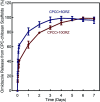
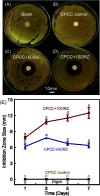


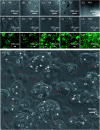
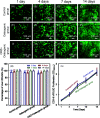
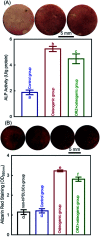
Similar articles
-
Antibacterial calcium phosphate cement with human periodontal ligament stem cell-microbeads to enhance bone regeneration and combat infection.J Tissue Eng Regen Med. 2021 Mar;15(3):232-243. doi: 10.1002/term.3169. Epub 2021 Feb 3. J Tissue Eng Regen Med. 2021. PMID: 33434402
-
Novel calcium phosphate cement with biofilm-inhibition and platelet lysate delivery to enhance osteogenesis of encapsulated human periodontal ligament stem cells.Mater Sci Eng C Mater Biol Appl. 2021 Sep;128:112306. doi: 10.1016/j.msec.2021.112306. Epub 2021 Jul 10. Mater Sci Eng C Mater Biol Appl. 2021. PMID: 34474857 Free PMC article.
-
Injectable periodontal ligament stem cell-metformin-calcium phosphate scaffold for bone regeneration and vascularization in rats.Dent Mater. 2023 Oct;39(10):872-885. doi: 10.1016/j.dental.2023.07.008. Epub 2023 Aug 12. Dent Mater. 2023. PMID: 37574338
-
Calcium phosphate cement scaffold with stem cell co-culture and prevascularization for dental and craniofacial bone tissue engineering.Dent Mater. 2019 Jul;35(7):1031-1041. doi: 10.1016/j.dental.2019.04.009. Epub 2019 May 7. Dent Mater. 2019. PMID: 31076156 Review.
-
Stem Cells and Calcium Phosphate Cement Scaffolds for Bone Regeneration.J Dent Res. 2014 Jul;93(7):618-25. doi: 10.1177/0022034514534689. Epub 2014 May 5. J Dent Res. 2014. PMID: 24799422 Free PMC article. Review.
Cited by
-
Periodontal ligament stem cell-based bioactive constructs for bone tissue engineering.Front Bioeng Biotechnol. 2022 Dec 2;10:1071472. doi: 10.3389/fbioe.2022.1071472. eCollection 2022. Front Bioeng Biotechnol. 2022. PMID: 36532583 Free PMC article. Review.
-
Biomaterial scaffolds in maxillofacial bone tissue engineering: A review of recent advances.Bioact Mater. 2023 Nov 10;33:129-156. doi: 10.1016/j.bioactmat.2023.10.031. eCollection 2024 Mar. Bioact Mater. 2023. PMID: 38024227 Free PMC article. Review.
-
Characterization and Antimicrobial Activity of Nigella sativa Extracts Encapsulated in Hydroxyapatite Sodium Silicate Glass Composite.Antibiotics (Basel). 2022 Jan 28;11(2):170. doi: 10.3390/antibiotics11020170. Antibiotics (Basel). 2022. PMID: 35203773 Free PMC article.
-
Sudoku of porous, injectable calcium phosphate cements - Path to osteoinductivity.Bioact Mater. 2022 Jan 10;17:109-124. doi: 10.1016/j.bioactmat.2022.01.001. eCollection 2022 Nov. Bioact Mater. 2022. PMID: 35386461 Free PMC article. Review.
-
Research Status and Trends in Periodontal Ligament Stem Cells: A Bibliometric Analysis over the Past Two Decades.Stem Cells Int. 2024 Sep 27;2024:9955136. doi: 10.1155/2024/9955136. eCollection 2024. Stem Cells Int. 2024. PMID: 39372680 Free PMC article.
References
-
- Jayasree R. Kumar T. S. Perumal G. Doble M. Ceram. Int. 2018;44:9227–9235. doi: 10.1016/j.ceramint.2018.02.133. - DOI
LinkOut - more resources
Full Text Sources

